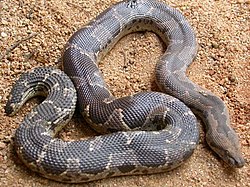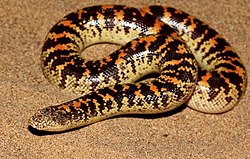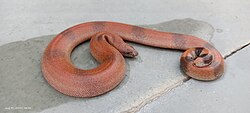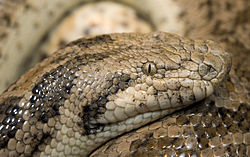en
names in breadcrumbs


Eryx is a genus of nonvenomous snakes, commonly known as Old World sand boas, in the subfamily Erycinae of the family Boidae.[2] Species of the genus are found in southeastern Europe, northern Africa, the Middle East, and southwestern Asia. Thirteen species are recognized as being valid.[2]
The genus Eryx has the following characters. The head is not distinct from the neck. The dorsal surface of the head is covered with small scales. The rostral is large. The eyes range from small to very small, and the pupils are vertical. The anterior maxillary teeth and anterior mandibular teeth are longer than the posterior ones. The body is almost cylindrical. The dorsal scales are smooth or keeled. The tail is very short, either not prehensile or only slightly prehensile. The subcaudals are undivided.[3]
Species of snakes of the genus Eryx are found in southeastern Europe, northern Africa, the Middle East, and southwestern Asia.[1]
Nota bene: In the list below, a taxon author in parentheses indicates that the species was originally described in a genus other than Eryx.
Species[2] Taxon author[2] Subspecies*[2] Common name Geographic range[1] Eryx borrii Lanza & Nistri, 2005 0 Borri's sand boa Somalia Eryx colubrinus (Linnaeus, 1758) 2 Egyptian sand boa, Kenyan sand boa Egypt, Sudan, South Sudan, Ethiopia, Eritrea, Kenya, Tanzania, Somalia Eryx conicus
(Linnaeus, 1758) 2 Egyptian sand boa, Kenyan sand boa Egypt, Sudan, South Sudan, Ethiopia, Eritrea, Kenya, Tanzania, Somalia Eryx conicus (Schneider, 1801) 0 Rough-tailed sand boa, common sand boa Pakistan, Nepal, India, Sri Lanka Eryx elegans (Gray, 1849) 0 Central Asian sand boa Southern Turkmenistan, northern Iran (the Kopet Dag Mountains in the northeast and the Azerbaijan region in the northwest) and Afghanistan Eryx jaculus
(Schneider, 1801) 0 Rough-tailed sand boa, common sand boa Pakistan, Nepal, India, Sri Lanka Eryx elegans (Gray, 1849) 0 Central Asian sand boa Southern Turkmenistan, northern Iran (the Kopet Dag Mountains in the northeast and the Azerbaijan region in the northwest) and Afghanistan Eryx jaculus (Linnaeus, 1758) 0 Javelin sand boa Eastern Europe in Romania, Bulgaria, Yugoslavia, Albania and Greece (including Corfu and the Cyclades). The Caucasus. The Middle East in Syria, Israel, northeastern Saudi Arabia, Iraq and Iran. Africa north of the Sahara Desert from Morocco to Egypt. Eryx jayakari
(Linnaeus, 1758) 0 Javelin sand boa Eastern Europe in Romania, Bulgaria, Yugoslavia, Albania and Greece (including Corfu and the Cyclades). The Caucasus. The Middle East in Syria, Israel, northeastern Saudi Arabia, Iraq and Iran. Africa north of the Sahara Desert from Morocco to Egypt. Eryx jayakari Boulenger, 1888 0 Arabian sand boa From the east and south of the Arabian Peninsula north to Khūzestān Province in Iran Eryx johnii
Boulenger, 1888 0 Arabian sand boa From the east and south of the Arabian Peninsula north to Khūzestān Province in Iran Eryx johnii (Russell, 1801) 0 Indian sand boa From Iran through Pakistan into northwestern and southern India Eryx miliaris
(Russell, 1801) 0 Indian sand boa From Iran through Pakistan into northwestern and southern India Eryx miliaris (Pallas, 1773) 0 Dwarf sand boa From the northern Caucasus and the north coast of the Caspian Sea east through Kazakhstan to the north coast of the Aral Sea and Lake Balkhash, though the Zaysan Valley to Sinkiang in China and southern Mongolia. Also in northern and eastern Iran, Afghanistan and western Pakistan. Eryx muelleri
(Pallas, 1773) 0 Dwarf sand boa From the northern Caucasus and the north coast of the Caspian Sea east through Kazakhstan to the north coast of the Aral Sea and Lake Balkhash, though the Zaysan Valley to Sinkiang in China and southern Mongolia. Also in northern and eastern Iran, Afghanistan and western Pakistan. Eryx muelleri (Boulenger, 1892) 1 Müller’s sand boa Mauritania, Senegal, Gambia, Guinea, Mali, Burkina Faso, Niger, Chad, Sudan, South Sudan, the Ivory Coast, Ghana, Togo, Benin, Nigeria, Cameroon, the Central African Republic Eryx sistanensis Eskandarzadeh, N. Rastegar-Pouyani, E. Rastegar-Pouyani, Zargan, Hajinourmohamadi, Nazarov, Sami, Rajabizadeh, Nabizadeh & Navaian, 2020 0 Sistan sand boa Iran Eryx somalicus Scortecci, 1939 0 Somali sand boa Somalia Eryx vittatus (Chernov, 1959) 0 Northern Iran, Tajikistan, northern Afghanistan, northern Pakistan, Kyrgyzstan, and eastern China Eryx whitakeri
(Boulenger, 1892) 1 Müller’s sand boa Mauritania, Senegal, Gambia, Guinea, Mali, Burkina Faso, Niger, Chad, Sudan, South Sudan, the Ivory Coast, Ghana, Togo, Benin, Nigeria, Cameroon, the Central African Republic Eryx sistanensis Eskandarzadeh, N. Rastegar-Pouyani, E. Rastegar-Pouyani, Zargan, Hajinourmohamadi, Nazarov, Sami, Rajabizadeh, Nabizadeh & Navaian, 2020 0 Sistan sand boa Iran Eryx somalicus Scortecci, 1939 0 Somali sand boa Somalia Eryx vittatus (Chernov, 1959) 0 Northern Iran, Tajikistan, northern Afghanistan, northern Pakistan, Kyrgyzstan, and eastern China Eryx whitakeri Das, 1991 0 Whitaker's sand boa Southwestern coastal India in Kerala, Karnataka, Goa and southern Maharashtra
Das, 1991 0 Whitaker's sand boa Southwestern coastal India in Kerala, Karnataka, Goa and southern Maharashtra T) Type species.[1]
A new species, Eryx borrii, found in Somalia, was described by Lanza and Nistri (2005).[4] The specific name borrii is in honor of Italian zoologist Marco Borri.[5]
Eryx is a genus of nonvenomous snakes, commonly known as Old World sand boas, in the subfamily Erycinae of the family Boidae. Species of the genus are found in southeastern Europe, northern Africa, the Middle East, and southwestern Asia. Thirteen species are recognized as being valid.